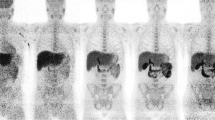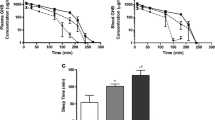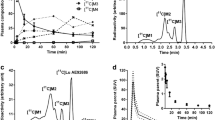Abstract
Radioiodinated metaiodobenzylguanidine (MIBG) has been shown to be extracted in the lung by an active, sodium-dependent, saturable transport system similar to that which extracts norepinephrine. Accordingly, first transit uptake of MIBG has been investigated as a method for in vivo evaluation of pulmonary biogenic amine metabolism. Issues that still must be resolved include the degree to which MIBG extraction is affected by simple loss of available vascular surface (in distinction to changes in amine metabolism). If MIBG lung extraction is altered by loss of pulmonary vascular surface alone, then a tracer must be found that can serve as a simultaneous monitor of vascular surface loss in order to allow normalization of the MIBG data. One tracer with such potential is radioiodinated iodoamphetamine (IMP). Accordingly, an experimental model of pulmonary vascular surface loss (lobar ligatures) was applied in an isolated-perfused lung model with simultaneous administration of MIBG and IMP. A linear relationship was found between MIBG extraction and percent lung surface loss by weight (n=21, r=0.75, P0.05). Addition of IMP (1 or 10 μM) to media containing MIBG (1 μM) (n=28) inhibited overall MIBG extraction, but decreases in MIBG uptake with vascular surface loss were otherwise parallel to those in experiments without IMP. IMP, however, did not adequately reflect vascular surface loss at the concentrations used in this study (extraction of IMP 1 μM=31.2±12.9% in control vs 32.7%±7.7% with greater than 50% lung surface loss, n=18, P=NS). The results indicate that a correction for vascular surface loss is needed to interpret MIBG results in vivo, but suggest that IMP is not able to serve this purpose.
Similar content being viewed by others
References
Abrams DN, Paul Man SF, Noujaim AA (1987) Evaluation of the lung uptake of iodine-131 HIPDM by the single-pass multiple indicator dilution. J Nucl Med 28:487–494
Akber SF (1987) A noninvasive assessment of pharmacological interactions of amines in the lung. Nucl Med Com 8:889–893
Anderson MW, Orton TC, Pickett RD, Eling TE (1973) Accumulation of amines in the isolated perfused rabbit lung. J Pharmacol Exp Ther 189:456–465
Dargent F, Neidhart P, Bachmann M, Suter PM, Junod AF (1985a) Simultaneous measurement of serotonin and propranol pulmonary extraction in patients after extracorporeal circulation and surgery. Am Rev Resp Dis 131:242–245
Dargent F, Gardaz J-P., Morel P, Suter PM, Junod AF (1985b) Effects of atelectasis and vascular occlusion on the simultaneous measurement of serotonin and propranolol pulmonary extraction in dogs. Clin Sci 69:279–286
Dollery CT, Junod AF (1976) Concentration of (+/-)-propranolol in isolated perfused lungs of rat. Br J Pharmacol 57:67–71
Gillis CN (1986) Pharmacological aspects of metabolic processes in the pulmonary circulation. Ann Rev Pharmacol Toxicol 26:183–200
Junod AF (1972a) Uptake, metabolism and efflux of 14C-5-hydroxy tryptamine in isolated perfused rat lungs. J Pharmacol Exp Ther 183:341–355
Junod AF (1985) 5-hydroxytryptamine and other amines in the lungs. In: American Physiological Society, Bethesda, Maryland (ed) Handbook of Physiology. The respiratory system 1, section 3, Vol 1, pp 337–349
Morel DR, Dargent F, Bachman M, Suter PM, Junod AF (1985) Pulmonary extraction of serotonin and propranolol in patients with adult respiratory distress syndrome. Am Rev Resp Dis 132:479–484
Rahimian J, Glass EC, Touya JJ, Akber SF, Graham LS, Bennett LR (1984) Measurement of metabolic extraction of tracers in the lung using a multiple indicator dilution technique. J Nucl Med 25:31–37
Slosman DO, Brill AB, Polla BS, Alderson PO (1987) Evaluation of (iodine 125) N,N,N′,-trimethyl-propanediamine lung uptake using an isolated perfused rat lung. J Nucl Med 28:203–208
Slosman DO, Davidson D, Brill AB, Alderson PO (1988a) 131I-metaiodo-benzylguanidine uptake in the isolated perfused rat lung: a potential marker of endothelial cell function. Eur J Nucl Med 13:543–547
Slosman DO, Morel DR, Mo Costabella P, Suter PM, Donath A (1988b) Lung uptake of 131-metaiodobenzylguanidine in sheep: an in-vivo measurement of endothelial cell function. Eur J Nucl Med 14:65–70
Slosman DO, Morel DR, Alderson PO (1988c) A new imaging approach to quantitative evaluation of pulmonary vascular endothelial metabolism. J Thorac Imag 3:49–52
Syrota A, Pascal O, Crouzel M, Kellersohn C (1981) Pulmonary extraction of 11C-chlorpromazine measured by residue detection in man. J Nucl Med 22:145–148
Author information
Authors and Affiliations
Additional information
Supported in part by the Swiss National Foundation for Scientific Research under cotract no 3.985-0.86
Rights and permissions
About this article
Cite this article
Slosman, D.O., Donath, A. & Alderson, P.O. 131I-metaiodobenzylguanidine and 125I-iodoamphetamine. Eur J Nucl Med 15, 207–210 (1989). https://doi.org/10.1007/BF00253797
Received:
Accepted:
Issue Date:
DOI: https://doi.org/10.1007/BF00253797




